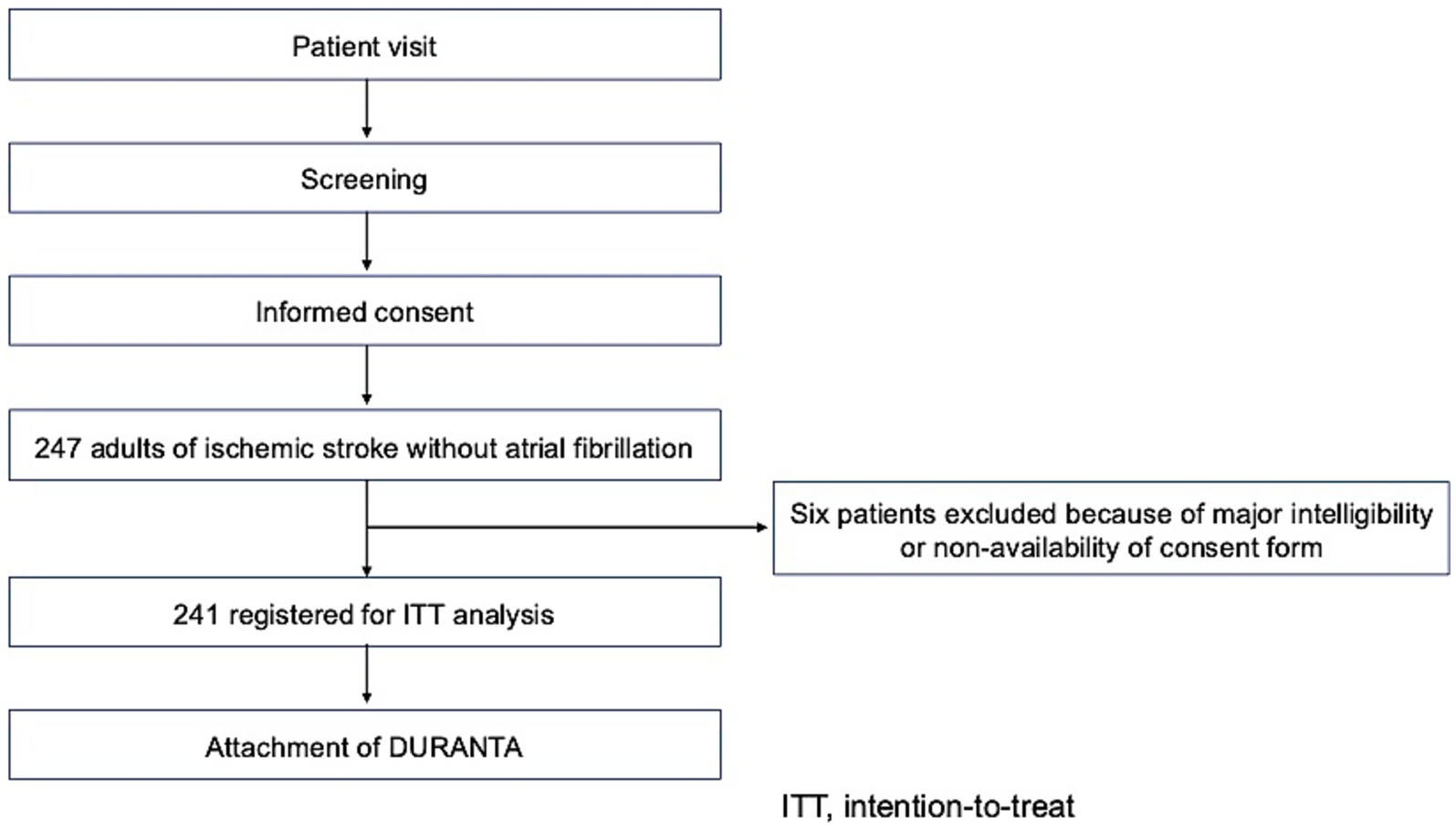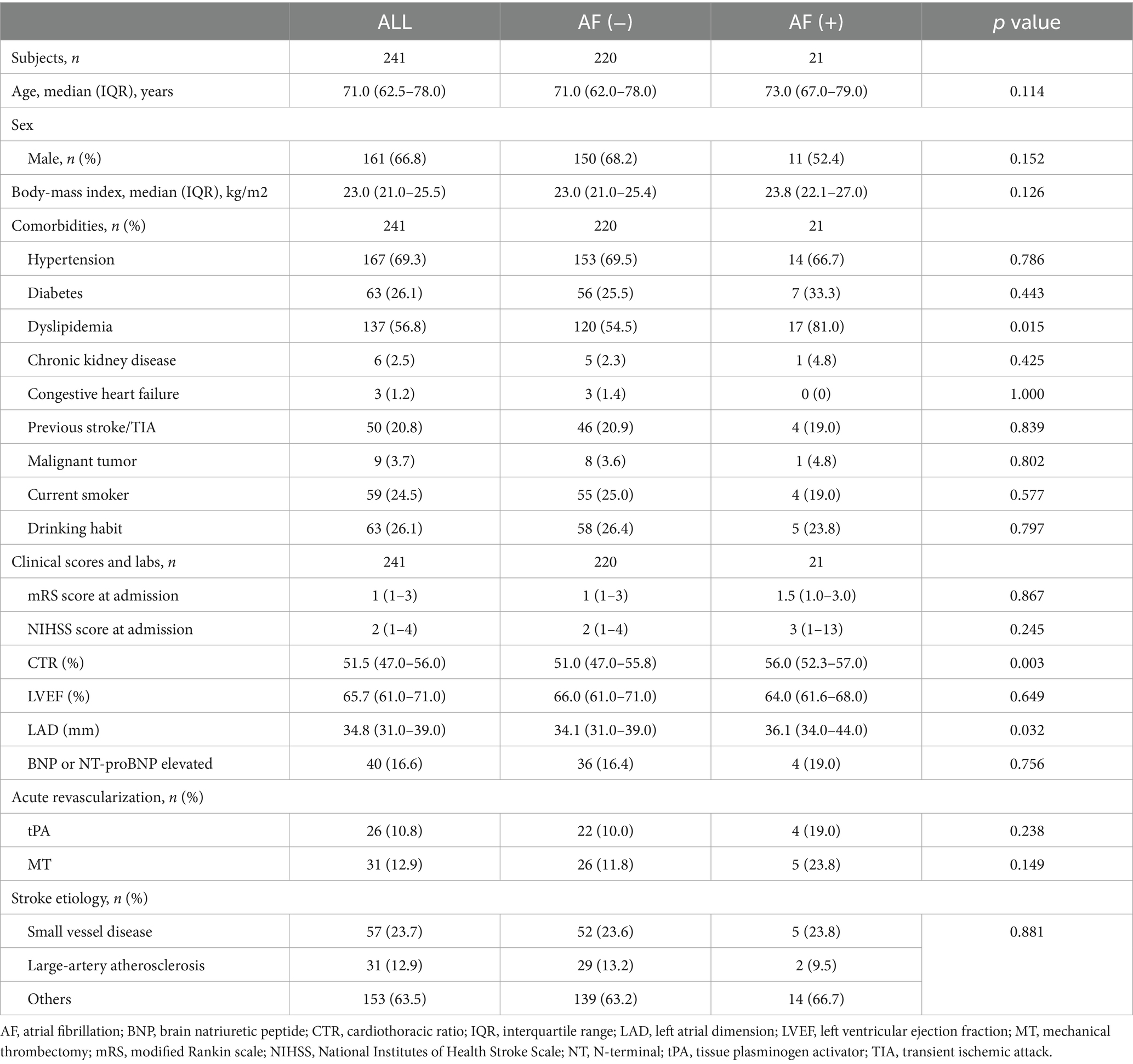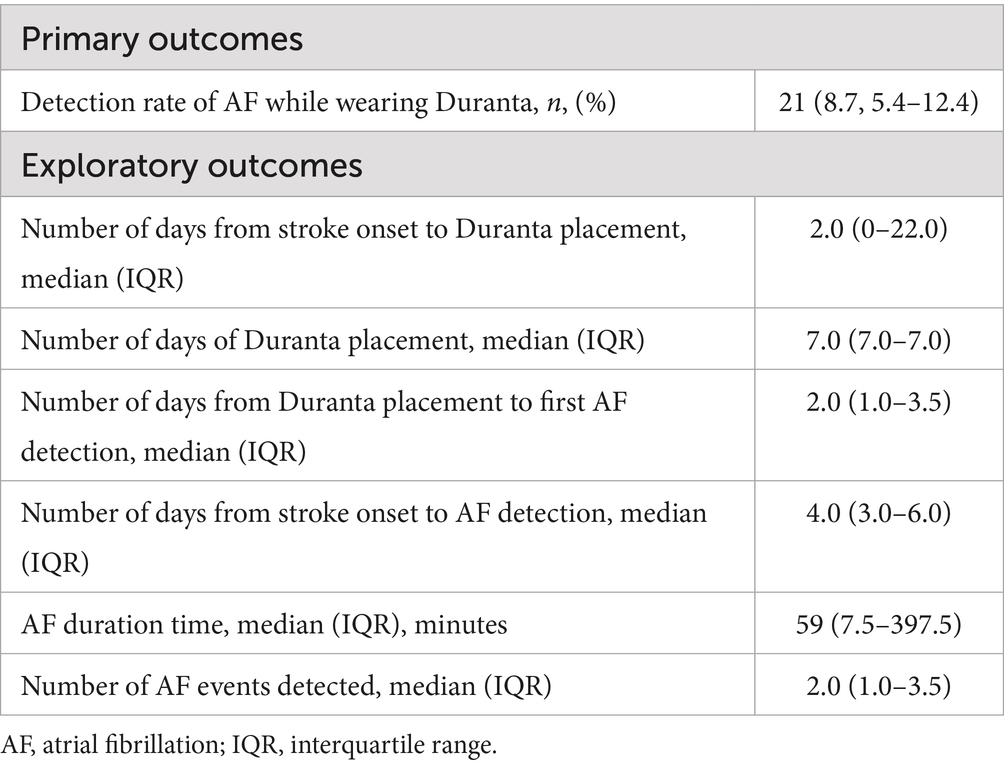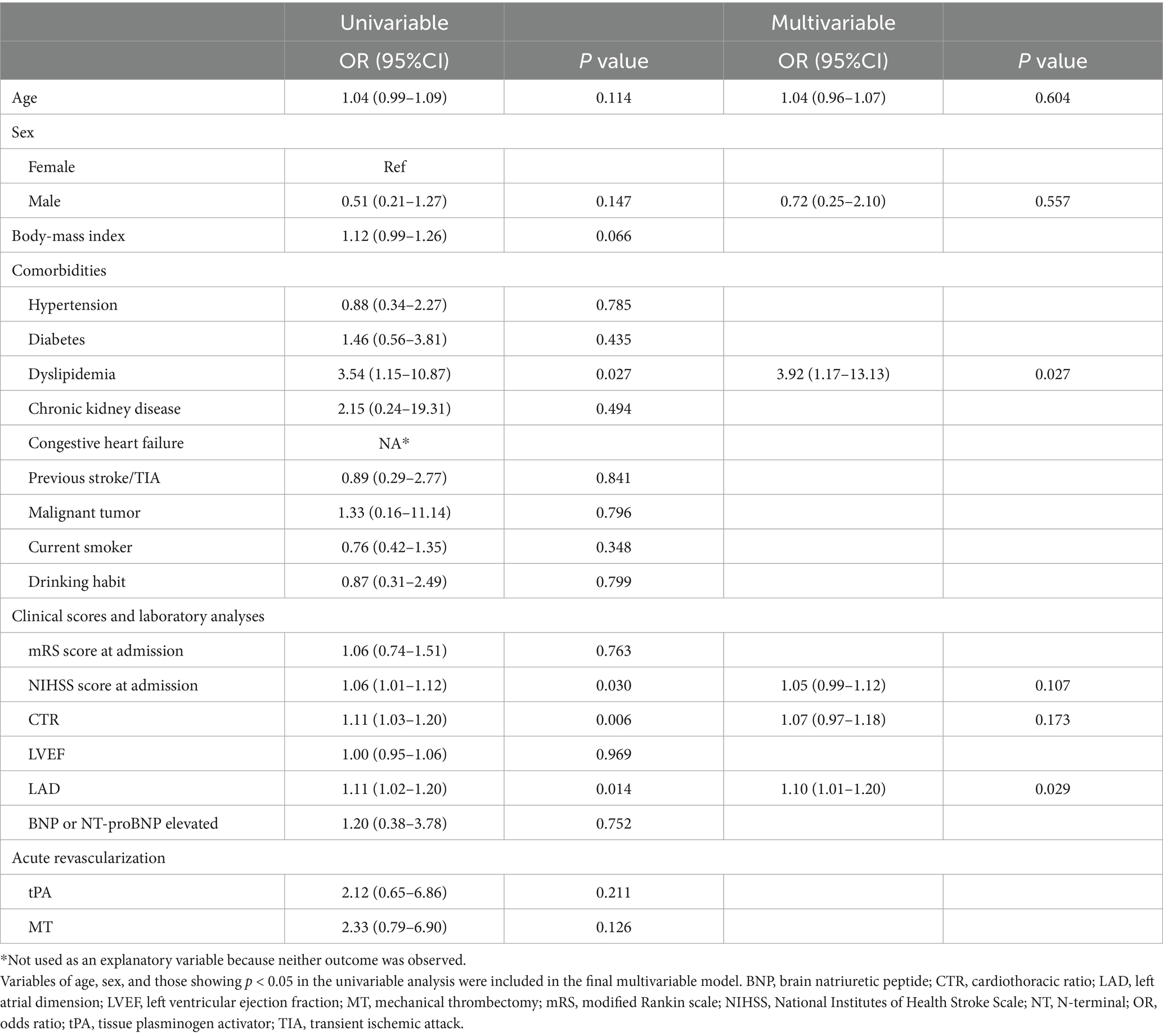- 1Department of Neurology, Graduate School of Medicine, Nippon Medical School, Tokyo, Japan
- 2Division of Medicine, Department of Neurology, Faculty of Medical Sciences, University of Fukui, Fukui, Japan
- 3Department of Hygiene and Public Health, Graduate School of Medicine, Nippon Medical School, Tokyo, Japan
- 4Department of Cerebrovascular Medicine, NTT Medical Center Tokyo, Tokyo, Japan
- 5Department of Neurology, The Jikei University School of Medicine, Tokyo, Japan
- 6Department of Neurology, Ichinomiya Nishi Hospital, Aichi, Japan
- 7Department of Cerebrovascular Medicine and Neurology, National Hospital Organization Kyushu Medical Center, Fukuoka, Japan
- 8Department of Neurology, Kita-Harima Medical Center, Hyogo, Japan
- 9Department of Neurology, Saiseikai Kumamoto Hospital, Kumamoto, Japan
- 10Primary Medical Science Department, Daiichi Sankyo Co., Ltd., Tokyo, Japan
- 11Data Intelligence Department, Daiichi Sankyo Co., Ltd., Tokyo, Japan
Objective: Stroke caused by atrial fibrillation (AF) is associated with high mortality and severe morbidity. Screening patients for AF may facilitate early initiation of anticoagulant therapy and prevent recurrent stroke; therefore, strategies to effectively detect AF in stroke patients are important.
Methods: This prospective multicenter study was conducted between April 27, 2020 and March 31, 2021 at seven sites in Japan, as a substudy of the STABLED trial, a multicenter prospective randomized study to evaluate the efficacy and safety of catheter ablation with anticoagulant therapy using edoxaban in patients with ischemic stroke and AF. This substudy included 241 patients who suffered ischemic stroke but had no diagnosis of AF. Patients were monitored with Duranta, a wearable non-invasive wireless patch ECG system. The primary outcome was the detection rate for AF while wearing Duranta.
Results: Of the 241 patients, 66.8% were men, and the mean age was 71.0 years. AF was detected in 21 of the 241 patients (8.7, 95% CI: 5.4–12.4) during follow-up using the Duranta wearable ECG system. ECG data were recorded for 7 days in all patients. The median number of days from stroke onset to Duranta placement was 2.0, but this duration varied considerably (median; IQR, 0–22.0). An adverse event of dermal pruritus was observed in 1 of the 241 patients (0.4%). Determinants for the detection of AF in patients with no previous history of AF were dyslipidemia and left atrial dimension.
Conclusion: Wearable wireless patch ECG systems such as Duranta are simple and efficient devices for detecting AF. In patients with ischemic stroke and no diagnosis of AF, their use for detecting new AF may provide benefit through early initiation of anticoagulants and prevention of recurrent stroke.
1 Introduction
Stroke is the fourth leading cause of death and long-term disability in Japan (1). Cardiogenic embolic stroke is mainly caused by atrial fibrillation (AF), which is a primary risk factor for ischemic stroke (2). AF-associated stroke is often severe, and is associated with high mortality and severe morbidity. In addition, because the risk of recurrent cardiogenic embolic stroke caused by AF can be significantly reduced by anticoagulants (3, 4), the detection of AF in patients with acute ischemic stroke is important. However, AF is often absent on admission, as well as being paroxysmal or asymptomatic, making it difficult to detect with symptom-driven monitoring strategies. Therefore, several methods have been used to detect AF. Standard methods include 12-lead electrocardiography (ECG), Holter ECG, and long-term monitoring. However, because AF often still goes undetected, subcutaneous electrocardiographs are sometimes implanted in the patient’s chest, but these subcutaneous implantable devices are invasive, and there is a high demand for non-invasive methods that perform better in the detection of AF than the Holter-type ambulatory ECG. Currently, non-invasive devices, such as the ZIO patch (5), mobiCARE-MC100 TM (6), and AliveCor device (7), can effectively detect AF, although their use is not widespread. In addition, there are a number of non-regulatory consumer-based healthcare products that are capable of detecting AF, such as the Apple Watch series, although these are not certified for medical use, and their accuracy is insufficiently documented (8).
The STroke secondary prevention with catheter ABLation and EDoxaban (STABLED) trial in patients with non-valvular AF is a multicenter prospective randomized ongoing clinical trial to evaluate the efficacy and safety of catheter ablation with anticoagulant therapy using edoxaban in patients with AF and a history of recent ischemic stroke (9). In this substudy to the clinical trial, we took advantage of the data recorded from a particular cohort of patients who had recently suffered ischemic stroke (within 6 months) but had no history of non-valvular AF, and who were monitored for 7 days post-stroke using a relatively new device called Duranta, which is an iPhone-based single-lead electrocardiographic capture system (ZAIKEN, Co. Ltd., Tokyo, Japan). ECG data captured by the system are automatically transmitted to a cloud server via a dedicated iPhone. Duranta is non-invasive and can be easily attached and removed during hospitalization. The primary aim of this study was to evaluate the potential of a wearable ECG device for detecting AF in patients who had recently suffered ischemic stroke, and not to make direct comparisons between different devices.
In this companion study, we evaluated the detection rate of AF during hospitalization and the number of days when AF was most frequently detected by the Duranta system in the STABLED candidate stroke patients without a diagnosis of AF. Moreover, we made further analyses comparing clinical factors in the group in which AF was detected with those in the non-detection group.
2 Materials and methods
2.1 Study design
This multicenter prospective study was conducted between April 27, 2020 and March 31, 2021 at seven sites in Japan. A list of all participating institutions and their investigators is provided in Supplementary Table S1.
The protocol was approved by the Nippon Medical School Certified Clinical Research Review Board (approval no. CRB3180001) and prospectively registered with the Japan Registry of Clinical Trials (registration no. jRCT s032200054; https://jrct.niph.go.jp/latest-detail/jRCTs032200054). The study was conducted in accordance with the Declaration of Helsinki and the Clinical Trials Act in Japan. All study participants provided written informed consent before enrollment. The study design is summarized in Figure 1.
2.2 Study participants
The eligible patients were candidates for the STABLED trial. The study patients were required to satisfy all of the defined inclusion criteria and none of the exclusion criteria. Briefly, the inclusion criteria were: (1) age ≥20 and ≤85 years at the time of informed consent, (2) no history of non-valvular AF, (3) history of ischemic stroke in the previous 6 months, and (4) a modified Rankin Scale ≤3 or expected to improve to ≤3 with treatment. The major exclusion criteria were: (1) severe renal impairment (creatinine clearance rate <30 mL/min), (2) markedly reduced cardiac function (ejection fraction <35%), (3) atrial septal defect, (4) being unlikely to complete the study because of progressive malignancy, (5) participation or planning to participate in another interventional clinical trial, and (6) otherwise judged as not being suitable for the study by the investigators.
2.3 Duranta: single-lead ECG monitor
The Duranta wireless non-invasive patch ECG monitoring system (Medical Device Certificate Number 226AIBZX00055000) is a small and lightweight device (78.4 mm wide × 35.1 mm deep × 14.7 mm thick, 35 g) with two patch electrodes; the device is placed in a precordial position (Figure 2A). The battery lasts for up to 7 consecutive days without recharging. ECG data are automatically transmitted to a cloud server via a dedicated iPhone (Figure 2B). Medical staff can access the cloud server with a personal ID and password, view the patient’s ECG in real time on an iPad, and download the ECG data to a computer in the hospital. For this study, ECG recording was started immediately after the main switch was turned on, and the recorded waveform data were sent to a nearby iPhone via Bluetooth, and then further relayed to a cloud server via a 3G/4G/LTE/Wi-Fi network. The patients’ personal information was not entered into the ECG devices, and there was therefore no risk of personal data leakage during the data delivery from the ECG devices.
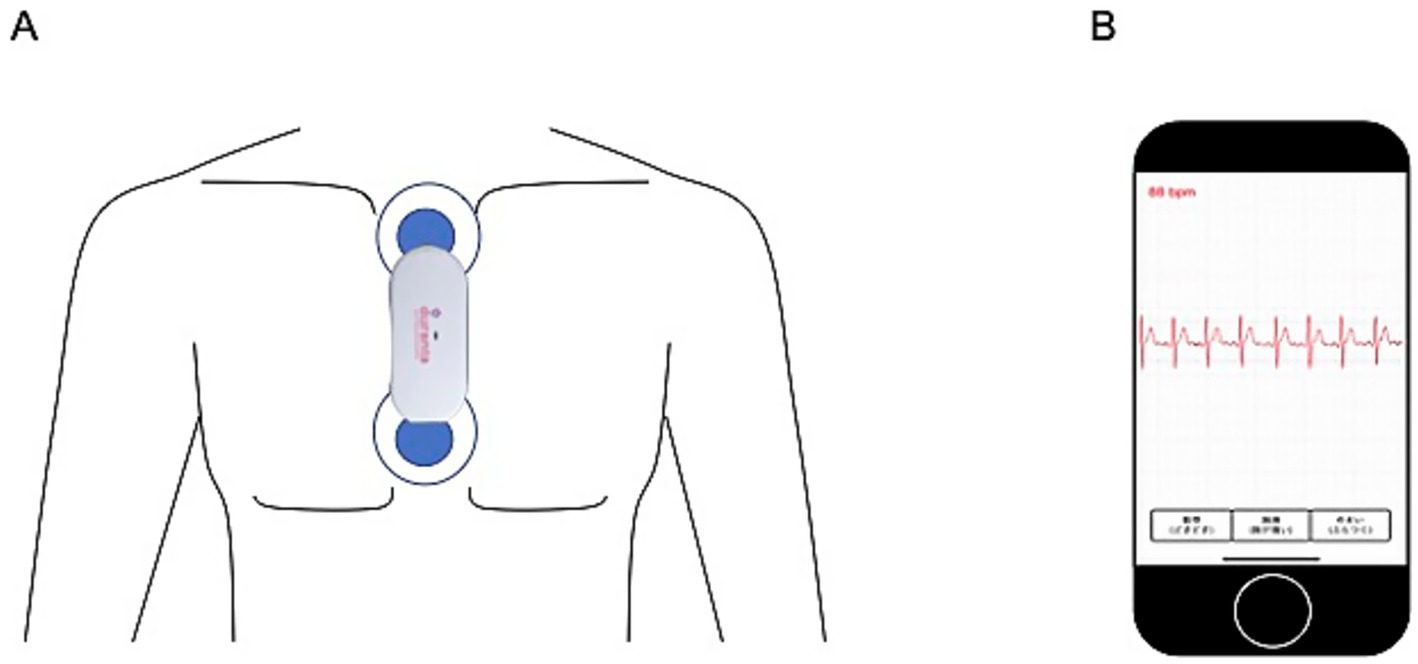
Figure 2. The Duranta wireless patch-type electrocardiographic monitoring system. The monitor is placed in a precordial position with a pair of electrode patches (A). Recorded waveform data are sent to a bedside iPhone (B) via Bluetooth and then to a cloud server. Real-time ECG data can be checked on the iPhone. Physicians or medical staff can access the data on cloud server from PCs in the hospital for real-time observation.
2.4 Data collection
The following clinical information was obtained from the study data set: age, sex, ethnicity, body mass index, hypertension, dyslipidemia, diabetes, chronic kidney disease, congestive heart failure, and history of stroke or transient ischemic attack. In addition, current smoking, dementia, drinking habits, malignancy (active), modified Rankin Scale score, and National Institutes of Health Stroke Scale (NIHSS) score at baseline were assessed. The cardiothoracic ratio and brain natriuretic peptide (BNP) or N terminal (NT)-proBNP were also measured. Elevated BNP and NT-proBNP levels were defined as BNP > 100 pg./mL and NT-proBNP > 400 pg./mL (10). Transthoracic echocardiography measurements were performed at baseline by sonographers at each medical institution. The left ventricular ejection fraction and left atrial dimension (LAD) were evaluated. This study included patients with symptomatic ischemic stroke identified on magnetic resonance imaging (MRI) and diagnosed by Japanese stroke specialists. Diagnoses of hypertension, dyslipidemia, diabetes, renal dysfunction, and congestive heart failure were made by the responsible physicians at each site based on the results of medications, blood tests, and chest X-rays.
2.5 Outcomes
The primary outcome was the AF detection rate while wearing Duranta. Exploratory outcomes included the number of days from Duranta placement to AF detection, number of days from stroke onset to AF detection, AF duration time, number of days from stroke onset to Duranta placement, number of AF events detected during Duranta placement, and duration of Duranta placement. Safety outcomes included any adverse events due to Duranta placement.
2.6 Statistical analyses
Continuous variables are expressed as median (interquartile range [IQR]), or number (%). Categorical data are expressed as the number of subjects (%). For comparisons of baseline characteristics, clinical characteristics, and examination-related factors between patients in whom Duranta detected AF and those in whom it did not, the chi-squared (χ2) test was used for categorical variables, and the Mann–Whitney test was used for continuous variables. Univariate analysis and multivariate logistic regression analysis were performed to identify factors (demographics, comorbidities, laboratory findings, physical examinations, age, and sex) associated with the detection of AF, with variables demonstrating p < 0.05 in the univariable test being entered into the multivariate logistic regression. Statistical significance was set at p < 0.05. All analyses were performed with SPSS version 27.0 (IBM, Armonk, NY), while the 95% confidence intervals for AF detection rates were calculated using Stata version 17 (StataCorp LLC, College Station, TX).
3 Results
3.1 Baseline characteristics of the patients
A total of 241 patients were enrolled in this study (161 men, 80 women). The median patient age was 71.0 years (IQR: 62.5–78.0) for all patients, 71.0 years (IQR: 62.0–78.0) for patients without AF (AF−), and 73.0 years (IQR: 67.0–79.0) for patients with AF (AF+). The clinical characteristics of the patients are summarized in Table 1. Dyslipidemia (AF−: 120 patients [54.5%], AF+: 17 patients, [81.0%], p = 0.02), cardiothoracic ratio (AF−: 51.0 [IQR 46.9–55.9], AF+: 56.0 [IQR 52.2–57.0], p = 0.003), and LAD (AF−: 34.1 [IQR 31.0–39.0], AF+: 36.1 [IQR 33.8–44.5.], p = 0.032) were significantly different between the groups (Table 1).
3.2 Primary and exploratory outcomes
AF, the primary outcome for this study, was detected in 21 of the 241 patients (8.7, 95% CI: 5.4–12.4) during follow-up using Duranta. The median number of days from Duranta placement to first AF detection was 2.0 (IQR: 1.0–3.5), the median AF duration time was 59 min (IQR: 7.5–397.5), the median number of AF detections in the AF + group was 2.0 (IQR: 1.0–3.5), the median number of days from stroke onset to AF detection was 4.0 (IQR: 3.0–6.0), and the duration of Duranta placement was 7 days in all patients (Table 2).
3.3 Adverse events
An adverse event occurred in only 1 (0.4%) of the 241 patients during Duranta placement. This was a case of dermal pruritus.
3.4 Time from stroke onset to Duranta placement in 21 patients with AF detected
Patients could be enrolled up to 6 months after stroke onset, and therefore Duranta was not always placed promptly after admission. Among the 21 patients in whom AF was detected, the median number of days from stroke onset to Duranta placement was 2.0 (IQR: 1.0–22.0), with 41.9% being equipped with Duranta 1 day after stroke onset, 47.6% between 2 and 4 days after stroke onset, and 9.5% 5 days or more after stroke onset (Figure 3).
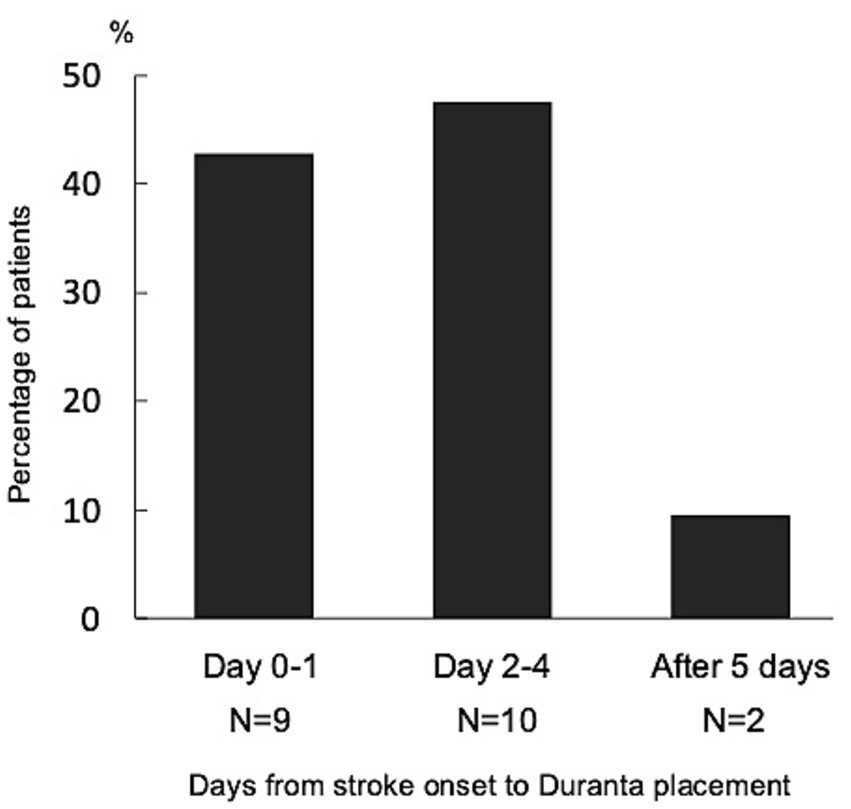
Figure 3. Time from stroke onset to Duranta was placed within 1 day after stroke onset in 9 patients (42.9%) of 21 patients with AF detected, between 2 and 4 days after stroke onset in 10 patients (47.6%), and 5 days or more after stroke onset in 2 patients (9.5%).
3.5 Probability of new AF within the duration of Duranta placement
According to the Kaplan–Meier curve, the cumulative incidence rates for detection of AF were 0.029, 0.067, 0.084, and 0.88 at days 1, 3, 5, and 7 of Duranta placement, respectively (Figure 4).
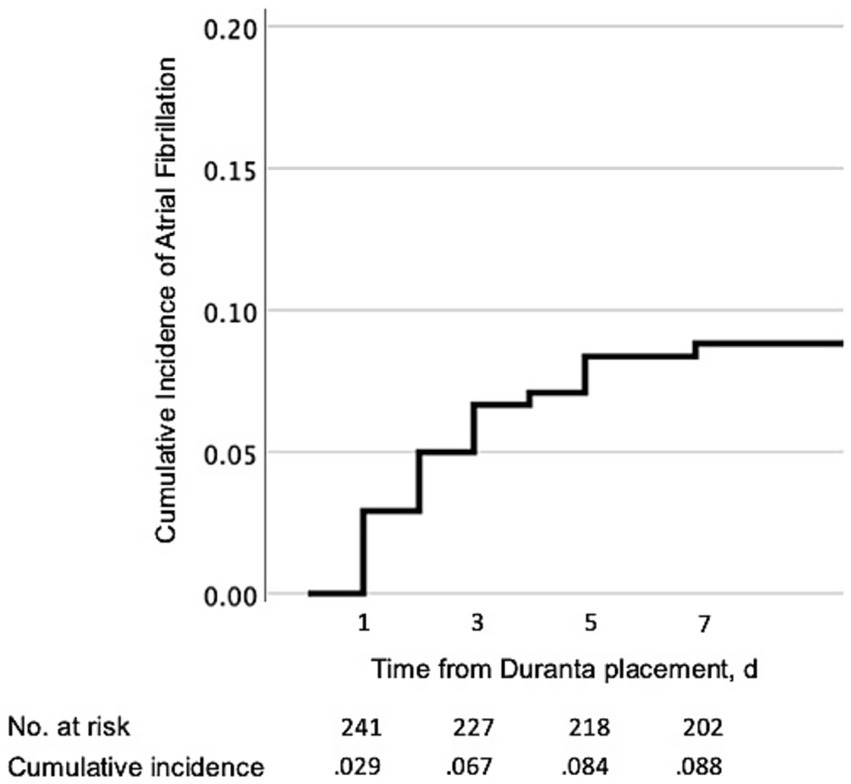
Figure 4. Kaplan–Meier curve for the cumulative incidence of detection of new atrial fibrillation with Duranta. The cumulative incidence rates at days 3 and 7 were 0.067 and 0.088, respectively. Most cases were detected within 3 days.
3.6 Determinants of AF detection with Duranta
In the univariable analysis, dyslipidemia, NIHSS score at admission, cardiothoracic ratio, and LAD were identified as determinants of AF detection using Duranta. In the multivariable analysis, we adjusted for multiple potential confounders such as age, sex, dyslipidemia, NIHSS score at admission, cardiothoracic ratio, and LAD, and only dyslipidemia (adjusted odds ratio [aOR]: 3.92, 95% CI: 1.17–13.13, p = 0.027) and LAD (aOR: 1.10, 95% CI: 1.01–1.20, p = 0.029) were significantly associated with AF detection by Duranta (Table 3).
4 Discussion
This prospective multicenter study of patients with ischemic stroke in Japan investigated the detection of new atrial fibrillation with a non-invasive device, an iPhone-based single-lead electrocardiographic capture system.
When a patient with AF has a stroke, it is often severe (2) and the recurrence rate is high (11, 12), although anticoagulants are highly effective in preventing recurrence (3, 4). Therefore, when a patient without a history of AF has a stroke, tests to detect AF are routinely performed, usually ECG and Holter ECG (13). Compared with 24-h ECG recordings, 7-day Holter ECG recordings were shown to have better detection of AF (14, 15). Although implantable ECGs have been shown to provide a high level of evidence for the detection of AF after thorough evaluation (16, 17), insertable cardiac monitors are invasive to the patient and can cause adverse events, and early implantation after the onset of stroke is generally not performed. In addition, early rhythm control for AF improves the primary clinical outcome (18). Given the high rate of recurrent strokes in patients with AF, if a patient without a history of AF has a stroke and is subsequently found to have AF, prompt administration of anticoagulation to reduce the risk of recurrence and early intervention for rhythm control of AF are required. These require heart rate monitoring that is as simple and safe as possible for several days or longer, starting as early as possible after stroke onset.
This study enrolled patients without a known history of AF and without AF on the admission 12-lead ECG. If AF was observed on the admission ECG, the patient would have been diagnosed with cardioembolic stroke and excluded. Therefore, the study included patients with lacunar infarction, as well as those with cryptogenic stroke and embolic stroke of undetermined source (ESUS); however, at the time of admission, testing to determine the stroke etiology (e.g., transthoracic echocardiography, Holter ECG, transesophageal echocardiography, lower limb venous ultrasound, cerebral angiography, contrast-enhanced CT) was incomplete, so a definitive diagnosis of cryptogenic stroke or ESUS could not be made at that point. We can therefore only describe the patients as “ischemic stroke cases without AF on admission ECG.” We believe the population likely includes cases that would eventually receive a diagnosis of cryptogenic stroke or ESUS after further testing.
According to the European Society of Cardiology 2020 guidelines (19), single-lead ECG recording using a wearable device can be used to confirm the diagnosis of AF (recommendation: Ia). In addition, a recent systematic review and meta-analysis suggests that non-invasive rhythm monitoring strategies should precede invasive monitoring (20). Detection of AF with wearable electrocardiographs, including patch ECG devices and wristwatch health products, has been reported. Studies such as the Apple Heart Study (21) and SCREEN-AF (SCREENing for Atrial Fibrillation) (22) using a single-lead ECG have recently demonstrated the feasibility and effectiveness of single-lead ECG recorders for detecting AF after stroke. However, the results of these studies were based on data from the general population and were not specific to patients with ischemic stroke or transient ischemic attack (23). Wristwatch devices are simple and have the potential to screen many asymptomatic and symptomatic patients; however, these devices use a photoplethysmograph sensor to detect atrial fibrillation when checking heartbeats in the background (24), and they demonstrate variable sensitivity and specificity and do not have acceptable accuracy compared with prescribed ECG devices. In comparison, a patch ECG device usually uses a single channel of bipolar induction over the heart to record the ECG.
In this study, we used Duranta, a patch-type wireless real-time ECG monitor that is easy to attach to the patient. Duranta is iPhone-based, and one of the features of this system is that it is very easy to attach and remove if the patient has to go for other examinations such as CT, MRI, or echography, as well as to use the restroom or take a bath during their hospital stay.
The AF detection rate of the Duranta system was 8.7%, which is higher than the 4–5% (22, 25) reported in screening studies and the 5–7% (5, 26) in studies with a population of stroke patients. Furthermore, it is higher than the AF detection rate of 6.8% in a study using 7-day Holter monitoring in patients who suffered a recent embolic stroke of undetermined source (26). However, the data used in this study came from a subset of patients recruited to the STABLED trial who underwent monitoring with the Duranta system, and within the scope of this study, it is not possible to accurately compare the performance of the Duranta system in comparison with similar systems; other similar single-lead and patch portable ECG systems would likely provide similar results, with the evidence suggesting that the Duranta system is at least on a par with similar systems.
In this study, LAD and dyslipidemia were found to be associated with detection of AF after adjusting for confounding factors. Left atrial enlargement is well known to be an inducer of AF (27); the larger the left atrial size, the greater the risk of developing AF (28). Recently, prespecified analysis of the STROKE AF randomized clinical trials found that only congestive heart failure and left atrial enlargement were significant predictors of AF (29). Another study reported that not only left atrial enlargement, but also the left atrial volume index (LAVI), calculated by dividing the left atrial volume by the body surface area, was higher in an AF + group than in an AF− group (30). Unfortunately, because this was a multicenter registry study, echocardiography was not performed for all patients and LAVI was thus excluded from the statistical analysis. Therefore, LAD was used as a valuable clinical predictor for the detection of AF.
The finding of the association between dyslipidemia and AF appears to be complex and paradoxical. In a previous study, higher total cholesterol (TC) and low-density lipoprotein cholesterol (LDL-C) levels were inversely associated with the incidence of AF over a mean follow-up period of 7.12 years (31). Low high-density lipoprotein (HDL) cholesterol was associated with an increased risk of new-onset AF in women, but not in men (32). Low HDL-C levels and high triglyceride (TG) levels, which are markers of metabolic syndrome, are associated with a higher risk of AF (33, 34). Reports of dyslipidemia and AF remain inconclusive, although low HDL-C and high TG levels may be associated with AF because metabolic syndrome is reported to be associated with the risk for AF (35). However, as dyslipidemia was diagnosed by the physicians in this study, it is unclear which lipid fraction was abnormal.
This study has some potential limitations. First, we cannot generalize our findings to non-hospitalized patients because our study included only in-hospital patients with ischemic stroke. Second, this study was conducted only at Japanese sites, and therefore, it is unclear whether the results can be extrapolated to patients from other countries. Third, the number of participants included in the current epidemiological study was small, which may have affected our findings through a lack of statistical power. Fourth, the enrolled patients without a known history of AF and without AF on the admission 12-lead ECG included patients with lacunar infarction, as well as those with cryptogenic stroke and ESUS; however, at the time of admission, testing to determine the stroke etiology was incomplete, so a definitive diagnosis of cryptogenic stroke or ESUS could not be made at that point. Finally, for hypertension, dyslipidemia, diabetes, chronic kidney disease, and medical history, the presence or absence of comorbidities was recorded according to the physician in charge, and therefore information on oral medications and laboratory values was not available.
5 Conclusion
In this prospective multicenter study performed in Japan, we found that a non-invasive wireless patch ECG system, the iPhone-based single-lead electrocardiographic capture system Duranta, found AF in 21 out of 241 ischemic stroke patients without a previous history of AF. The median time from Duranta placement to first AF detection was 2 days. Determinants for AF detection in patients without a history of AF were dyslipidemia and LAD. In ischemic stroke patients with undiagnosed AF, the use of wireless patch ECG systems for detecting new AF may provide benefit in the form of early initiation of anticoagulant administration and prevention of recurrent stroke.
Data availability statement
The original contributions presented in the study are included in the article/Supplementary material, further inquiries can be directed to the corresponding author.
Ethics statement
The studies involving humans were approved by the Institutional Review Board of Nippon Medical School (Approval number: CRB3180001). The studies were conducted in accordance with the local legislation and institutional requirements. The participants provided their written informed consent to participate in this study.
Author contributions
TS: Conceptualization, Data curation, Investigation, Methodology, Project administration, Validation, Writing – original draft. YN: Conceptualization, Formal analysis, Methodology, Project administration, Validation, Writing – original draft, Writing – review & editing. TO: Formal analysis, Investigation, Methodology, Project administration, Supervision, Validation, Writing – review & editing. YS: Conceptualization, Data curation, Formal analysis, Methodology, Project administration, Validation, Writing – review & editing. SO: Data curation, Methodology, Project administration, Validation, Writing – review & editing. YI: Data curation, Methodology, Project administration, Validation, Writing – review & editing. KY: Data curation, Investigation, Methodology, Project administration, Writing – review & editing. YO: Data curation, Project administration, Validation, Writing – review & editing. HH: Data curation, Methodology, Validation, Writing – review & editing. TY: Data curation, Methodology, Validation, Writing – review & editing. MF: Conceptualization, Investigation, Supervision, Validation, Writing – review & editing. AT: Formal analysis, Funding acquisition, Investigation, Project administration, Resources, Validation, Writing – review & editing. TK: Data curation, Funding acquisition, Validation, Writing – review & editing. KK: Conceptualization, Investigation, Methodology, Project administration, Supervision, Validation, Writing – review & editing.
Funding
The author(s) declare that financial support was received for the research and/or publication of this article. This companion study to the STABLED trial was supported by Daiichi Sankyo Co., Ltd.
Acknowledgments
We thank Edanz (https://jp.edanz.com/ac) for editing a draft of this manuscript.
Conflict of interest
The authors declare that this study received funding from Daiichi Sankyo Co., Ltd. The funder had the following involvement in the study: study design, data analysis planning, data interpretation, and decision to submit the manuscript for publication. The funder but had no direct involvement in data management, direct access, or statistical analysis.
YN, TS, and YO received personal fees from Daiichi Sankyo Co., Ltd. YS, SO, YI, KY, and HH received lecture fees from Daiichi Sankyo Co., Ltd. MF and AT are employees of Daiichi Sankyo Co., Ltd. KK received lecture fees and research funding from Daiichi Sankyo Co., Ltd.
Generative AI statement
The authors declare that no Gen AI was used in the creation of this manuscript.
Publisher’s note
All claims expressed in this article are solely those of the authors and do not necessarily represent those of their affiliated organizations, or those of the publisher, the editors and the reviewers. Any product that may be evaluated in this article, or claim that may be made by its manufacturer, is not guaranteed or endorsed by the publisher.
Supplementary material
The Supplementary material for this article can be found online at: https://www.frontiersin.org/articles/10.3389/fneur.2025.1560495/full#supplementary-material
References
1. Tai, S-Y, Cheon, S, Yamaoka, Y, Chien, Y-W, and Lu, T-H. Changes in the rankings of leading causes of death in Japan, Korea, and Taiwan from 1998 to 2018: a comparison of three ranking lists. BMC Public Health. (2022) 22:926. doi: 10.1186/s12889-022-13278-7
2. Kimura, K, Minematsu, K, and Yamaguchi, T. Atrial fibrillation as a predictive factor for severe stroke and early death in 15,831 patients with acute ischaemic stroke. J Neurol Neurosurg Psychiatry. (2005) 76:679–83. doi: 10.1136/jnnp.2004.048827
3. Mazurek, M, Shantsila, E, Lane, DA, Wolff, A, Proietti, M, and Lip, GYH. Secondary versus primary stroke prevention in atrial fibrillation: insights from the Darlington atrial fibrillation registry. Stroke. (2017) 48:2198–205. doi: 10.1161/strokeaha.116.016146
4. Yoshimura, S, Koga, M, Sato, S, Todo, K, Yamagami, H, Kumamoto, M, et al. Two-year outcomes of anticoagulation for acute ischemic stroke with Nonvalvular atrial fibrillation - SAMURAI-NVAF study. Circ J. (2018) 82:1935–42. doi: 10.1253/circj.CJ-18-0067
5. Tung, CE, Su, D, Turakhia, MP, and Lansberg, MG. Diagnostic yield of extended cardiac patch monitoring in patients with stroke or TIA. Front Neurol. (2014) 5:266. doi: 10.3389/fneur.2014.00266
6. Jung, S, Lee, HA, Kang, IS, Shin, SH, Chang, Y, Woo Shin, D, et al. Clinical implications of atrial fibrillation detection using wearable devices in patients with cryptogenic stroke (CANDLE-AF) trial: design and rationale. Front Cardiovasc Med. (2022) 9:837958. doi: 10.3389/fcvm.2022.837958
7. Halcox, JPJ, Wareham, K, Cardew, A, Gilmore, M, Barry, JP, Phillips, C, et al. Assessment of remote heart rhythm sampling using the AliveCor heart monitor to screen for atrial fibrillation: the REHEARSE-AF study. Circulation. (2017) 136:1784–94. doi: 10.1161/circulationaha.117.030583
8. Hashimoto, K, Harada, N, and Kasamaki, Y. Can a patch electrocardiographic device be a leading actor for detecting atrial fibrillation? - diversifying electrocardiographic monitoring devices. Circ J. (2022) 86:189–91. doi: 10.1253/circj.CJ-21-0644
9. Sakamoto, Y, Nishiyama, Y, Iwasaki, YK, Daida, H, Toyoda, K, Kitagawa, K, et al. Design and rationale of the STroke secondary prevention with catheter ABLation and EDoxaban clinical trial in patients with non-valvular atrial fibrillation: the STABLED study. J Cardiol. (2019) 74:539–42. doi: 10.1016/j.jjcc.2019.06.002
10. Bozkurt, B, Coats, AJS, Tsutsui, H, Abdelhamid, CM, Adamopoulos, S, Albert, N, et al. Universal definition and classification of heart failure: a report of the Heart Failure Society of America, heart failure Association of the European Society of cardiology, Japanese heart failure society and writing Committee of the Universal Definition of heart failure: endorsed by the Canadian heart failure society, heart failure Association of India, Cardiac Society of Australia and new Zealand, and Chinese heart failure association. Eur J Heart Fail. (2021) 23:352–80. doi: 10.1002/ejhf.2115
11. Hart, RG, Coull, BM, and Hart, D. Early recurrent embolism associated with nonvalvular atrial fibrillation: a retrospective study. Stroke. (1983) 14:688–93. doi: 10.1161/01.str.14.5.688
12. Paciaroni, M, Agnelli, G, Falocci, N, Caso, V, Becattini, C, Marcheselli, S, et al. Early recurrence and cerebral bleeding in patients with acute ischemic stroke and atrial fibrillation: effect of anticoagulation and its timing: the RAF study. Stroke. (2015) 46:2175–82. doi: 10.1161/strokeaha.115.008891
13. Higgins, P, MacFarlane, PW, Dawson, J, McInnes, GT, Langhorne, P, and Lees, KR. Noninvasive cardiac event monitoring to detect atrial fibrillation after ischemic stroke: a randomized, controlled trial. Stroke. (2013) 44:2525–31. doi: 10.1161/strokeaha.113.001927
14. Jabaudon, D, Sztajzel, J, Sievert, K, Landis, T, and Sztajzel, R. Usefulness of ambulatory 7-day ECG monitoring for the detection of atrial fibrillation and flutter after acute stroke and transient ischemic attack. Stroke. (2004) 35:1647–51. doi: 10.1161/01.STR.0000131269.69502.d9
15. Carrarini, C, Di Stefano, V, Russo, M, Dono, F, Di Pietro, M, Furia, N, et al. ECG monitoring of post-stroke occurring arrhythmias: an observational study using 7-day Holter ECG. Sci Rep. (2022) 12:228. doi: 10.1038/s41598-021-04285-6
16. Bernstein, RA, Kamel, H, Granger, CB, Piccini, JP, Sethi, PP, Katz, JM, et al. Effect of long-term continuous cardiac monitoring vs usual care on detection of atrial fibrillation in patients with stroke attributed to large- or small-vessel disease: the STROKE-AF randomized clinical trial. JAMA. (2021) 325:2169–77. doi: 10.1001/jama.2021.6470
17. Sagris, D, Papanikolaou, A, Kvernland, A, Korompoki, E, Frontera, JA, Troxel, AB, et al. COVID-19 and ischemic stroke. Eur J Neurol. (2021) 28:3826–36. doi: 10.1111/ene.15008
18. Kirchhof, P, Camm, AJ, Goette, A, Brandes, A, Eckardt, L, Elvan, A, et al. Early rhythm-control therapy in patients with atrial fibrillation. N Engl J Med. (2020) 383:1305–16. doi: 10.1056/NEJMoa2019422
19. Hindricks, G, Potpara, T, Dagres, N, Arbelo, E, Bax, JJ, Blomström-Lundqvist, C, et al. 2020 ESC guidelines for the diagnosis and management of atrial fibrillation developed in collaboration with the European Association for Cardio-Thoracic Surgery (EACTS): the task force for the diagnosis and management of atrial fibrillation of the European Society of Cardiology (ESC) developed with the special contribution of the European heart rhythm association (EHRA) of the ESC. Eur Heart J. (2021) 42:373–498. doi: 10.1093/eurheartj/ehaa612
20. Noubiap, JJ, Agbaedeng, TA, Kamtchum-Tatuene, J, Fitzgerald, JL, Middeldorp, ME, Kleinig, T, et al. Rhythm monitoring strategies for atrial fibrillation detection in patients with cryptogenic stroke: a systematic review and meta-analysis. Int J Cardiol Heart Vasc. (2021) 34:100780. doi: 10.1016/j.ijcha.2021.100780
21. Perez, MV, Mahaffey, KW, Hedlin, H, Rumsfeld, JS, Garcia, A, Ferris, T, et al. Large-scale assessment of a smartwatch to identify atrial fibrillation. N Engl J Med. (2019) 381:1909–17. doi: 10.1056/NEJMoa1901183
22. Gladstone, DJ, Wachter, R, Schmalstieg-Bahr, K, Quinn, FR, Hummers, E, Ivers, N, et al. Screening for atrial fibrillation in the older population: a randomized clinical trial. JAMA Cardiol. (2021) 6:558–67. doi: 10.1001/jamacardio.2021.0038
23. Yan, B, Tu, H, Lam, C, Swift, C, Ho, MS, Mok, VCT, et al. Nurse led smartphone electrographic monitoring for atrial fibrillation after ischemic stroke: SPOT-AF. J Stroke. (2020) 22:387–95. doi: 10.5853/jos.2020.00689
24. Liao, MT, Yu, CC, Lin, LY, Pan, KH, Tsai, TH, Wu, YC, et al. Impact of recording length and other arrhythmias on atrial fibrillation detection from wrist photoplethysmogram using smartwatches. Sci Rep. (2022) 12:5364. doi: 10.1038/s41598-022-09181-1
25. Steinhubl, SR, Waalen, J, Edwards, AM, Ariniello, LM, Mehta, RR, Ebner, GS, et al. Effect of a home-based wearable continuous ECG monitoring patch on detection of undiagnosed atrial fibrillation: the mSToPS randomized clinical trial. JAMA. (2018) 320:146–55. doi: 10.1001/jama.2018.8102
26. Miyazaki, Y, Toyoda, K, Iguchi, Y, Hirano, T, Metoki, N, Tomoda, M, et al. Atrial fibrillation after ischemic stroke detected by chest strap-style 7-day Holter monitoring and the risk predictors: EDUCATE-ESUS. J Atheroscler Thromb. (2021) 28:544–54. doi: 10.5551/jat.58420
27. Goldberger, JJ, Arora, R, Green, D, Greenland, P, Lee, DC, Lloyd-Jones, DM, et al. Evaluating the atrial myopathy underlying atrial fibrillation: identifying the Arrhythmogenic and Thrombogenic substrate. Circulation. (2015) 132:278–91. doi: 10.1161/circulationaha.115.016795
28. Tsang, TS, Barnes, ME, Bailey, KR, Leibson, CL, Montgomery, SC, Takemoto, Y, et al. Left atrial volume: important risk marker of incident atrial fibrillation in 1655 older men and women. Mayo Clin Proc. (2001) 76:467–75. doi: 10.4065/76.5.467
29. Schwamm, LH, Kamel, H, Granger, CB, Piccini, JP, Katz, JM, Sethi, PP, et al. Predictors of atrial fibrillation in patients with stroke attributed to large- or small-vessel disease: a Prespecified secondary analysis of the STROKE AF randomized clinical trial. JAMA Neurol. (2023) 80:99–103. doi: 10.1001/jamaneurol.2022.4038
30. De Angelis, MV, Di Stefano, V, Franciotti, R, Furia, N, Di Girolamo, E, Onofrj, M, et al. Cryptogenic stroke and atrial fibrillation in a real-world population: the role of insertable cardiac monitors. Sci Rep. (2020) 10:3230. doi: 10.1038/s41598-020-60180-6
31. Li, X, Gao, L, Wang, Z, Guan, B, Guan, X, Wang, B, et al. Lipid profile and incidence of atrial fibrillation: a prospective cohort study in China. Clin Cardiol. (2018) 41:314–20. doi: 10.1002/clc.22864
32. Watanabe, H, Tanabe, N, Yagihara, N, Watanabe, T, Aizawa, Y, and Kodama, M. Association between lipid profile and risk of atrial fibrillation. Circ J. (2011) 75:2767–74. doi: 10.1253/circj.cj-11-0780
33. Sagris, D, Harrison, SL, and Lip, GYH. Lipids and atrial fibrillation: new insights into a paradox. PLoS Med. (2022) 19:e1004067. doi: 10.1371/journal.pmed.1004067
34. Ding, M, Wennberg, A, Gigante, B, Walldius, G, Hammar, N, and Modig, K. Lipid levels in midlife and risk of atrial fibrillation over 3 decades-experience from the Swedish AMORIS cohort: a cohort study. PLoS Med. (2022) 19:e1004044. doi: 10.1371/journal.pmed.1004044
Keywords: atrial fibrillation, ischemic stroke, wearable device, multicenter study, prospective study
Citation: Saito T, Nishiyama Y, Otsuka T, Sakamoto Y, Okubo S, Iguchi Y, Yamaguchi K, Okada Y, Hamaguchi H, Yonehara T, Fukuzawa M, Takita A, Katano T and Kimura K (2025) An efficient approach for detecting atrial fibrillation in ischemic stroke patients using a wearable device: a prospective multicenter substudy of the STABLED trial. Front. Neurol. 16:1560495. doi: 10.3389/fneur.2025.1560495
Edited by:
Patricia Martínez Sánchez, Torrecárdenas University Hospital, SpainReviewed by:
Kwon-Duk Seo, National Health Insurance Service Ilsan Hospital, Republic of KoreaFuxin Ma, Fujian Medical University, China
Copyright © 2025 Saito, Nishiyama, Otsuka, Sakamoto, Okubo, Iguchi, Yamaguchi, Okada, Hamaguchi, Yonehara, Fukuzawa, Takita, Katano and Kimura. This is an open-access article distributed under the terms of the Creative Commons Attribution License (CC BY). The use, distribution or reproduction in other forums is permitted, provided the original author(s) and the copyright owner(s) are credited and that the original publication in this journal is cited, in accordance with accepted academic practice. No use, distribution or reproduction is permitted which does not comply with these terms.
*Correspondence: Yasuhiro Nishiyama, ZnVrdW5vbW8xNkB1LWZ1a3VpLmFjLmpw
†These authors have contributed equally to this work
 Tomonari Saito
Tomonari Saito Yasuhiro Nishiyama
Yasuhiro Nishiyama Toshiaki Otsuka
Toshiaki Otsuka Yuki Sakamoto1
Yuki Sakamoto1 Yasuyuki Iguchi
Yasuyuki Iguchi Keiji Yamaguchi
Keiji Yamaguchi Takehiro Katano
Takehiro Katano